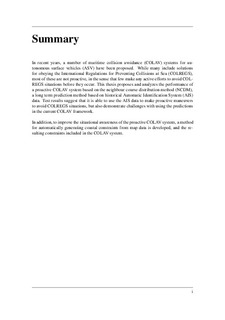| dc.contributor.advisor | Brekke, Edmund Førland | |
| dc.contributor.advisor | Eriksen, Bjørn-Olav Holtung | |
| dc.contributor.advisor | Kufoalor, Giorgio. D. Kwame Minde | |
| dc.contributor.author | Wu, David Huawei | |
| dc.date.accessioned | 2019-10-31T15:15:18Z | |
| dc.date.issued | 2019 | |
| dc.identifier | no.ntnu:inspera:35771502:18350702 | |
| dc.identifier.uri | http://hdl.handle.net/11250/2625767 | |
| dc.description.abstract | I de siste årene har det blitt utviklet flere maritime anti-kollisjonssystemer (COLAV-system) for autonome overflatefartøy (ASV). Mange metoder inkluderer løsninger for å følge Konvensjonen om internasjonale regler til forebygging av sammenstøt på sjøen (COLREGS), men ytterst få av disse prøver å aktivt unngå COLREGS-situasjoner før de finner sted. Denne oppgaven foreslår og tester ytelsen til et proaktivt COLAV system basert på neighbor course distribution method (NCDM), en prediksjonsmetode basert på Automatic Identification System (AIS) data. Testresultatene antyder at den klarer å utføre proaktive manøvre for å unngå COLREGS-situasjoner, men belyser også utfordringer rundt måten prediksjonene blir brukt i det nåværende COLAV-rammeverket. \\
For å forbedre situasjonsforståelsen til det proaktive COLAV-systemet, er det i tillegg blitt utviklet en metode for å generere begrensninger ved hjelp av kystlinjedata. Disse er blitt implementert i COLAV-systemet. | |
| dc.description.abstract | In recent years, a number of maritime collision avoidance (COLAV) systems for autonomous surface vehicles (ASV) have been proposed. While many include solutions for obeying the International Regulations for Preventing Collisions at Sea (COLREGS), most of these are not proactive, in the sense that few make any active efforts to avoid COLREGS situations before they occur. This thesis proposes and analyzes the performance of a proactive COLAV system based on the neighbour course distribution method (NCDM), a long term prediction method based on historical Automatic Identification System (AIS) data. Test results suggest that it is able to use the AIS data to make proactive maneuvers to avoid COLREGS situations, but also demonstrate challenges with using the predictions in the current COLAV framework. \\
In addition, to improve the situational awareness of the proactive COLAV system, a method for automatically generating coastal constraints from map data is developed, and the resulting constraints included in the COLAV system. | |
| dc.language | eng | |
| dc.publisher | NTNU | |
| dc.title | Proactive maritime collision avoidance based on historical AIS data | |
| dc.type | Master thesis | |
